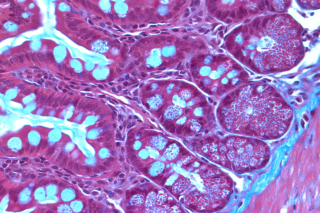
The Research Pathology Core Facility (RPF) is a fee-for-service facility located on the sixth floor of the E Pavillion (E-604.1 and E-621) of the Jewish General Hospital. The main function of this core is to provide the Researchers of the Segal Cancer Centre and the LDI as well as the Pharmaceutical Industry with technical expertise related to histology and pathology. The facility is equipped with top of the line instruments, including: Microtome Leica RM 2255 - Designed for fully motorized sectioning of paraffin embedded specimens; Cryostat Leica CM3050S - designed for motorized sectioning of frozen blocks; Immunostainer Ventana Discovery XT - with 30 slide positions, variable temperature control and flexible software options; Manual Tissue Arrayer MTA-1 - The manual arrayer allows for relatively easy construction of tissue microarrays with several hundred specimens. Typical size of an array is ~500 cases; and TMA Master - an automated and computer controlled tissue microarray (TMA) block creating machine that drills the recipient blocks and punches the donor blocks with high precision of 0.6, 1, 1.5 and 2 mm diameter. The Tissue Microarray (TMA) technique enables researchers to analyze several hundred tissue samples within a single paraffin block, providing highly efficient evaluation and assessment of the samples.
The RPF offers the following services:
- Consultation for experimental set up
- Project specific optimization of histological approaches
- Tissue harvesting
- Decalcification
- Paraffin and frozen tissue sectioning
- Basic and special stains (Giemsa- to differenciate between blood cells; Grocott- stain fungi; Masson’s Trichrome- stain connective tissue; Nissl- to identifie the basic neuronal structure in brain and spinal cord tissue; Oil Red O-lipid and triglycides detection; PAS- basement membrane and carbohydrates detection; Perl’s Iron- Iron detection; Reticulum silver- stain reticular fibers; Sirius Red- stain collagen; Verhoeff- stain elastic fibers; Von Kossa- calcium detection). For other histochemical stains, please send us an nbenlimame [at] jgh.mcgill.ca (email).
- Immunohistochemistry (paraffin and frozen samples)
- Immunofluorescence (Cells and tissues)
- Antibody titration and optimization
- Microscopic analysis by a pathologist
- Tissue microarray design and construction: TMA construction involves the transfer of multiple cores from conventional formalin fixed paraffin embedded (FFPE) patient (ie, archival pathology samples) or animal tissue(s) to a fresh recipient paraffin block. Following the assessment and selection of standard H&E tissue sections by a pathologist, tissue cores of 0.6 – 2.0 mm in diameter from a given FFPE tissue donor block are transferred to a recipient paraffin block. The recipient block, containing sample cores from hundreds of patients, can then be used to assess patterns of bio-marker expression within a population of patients. One advantage of this technology is that samples are handled identically. TMAs provide a method for rapid, large-scale molecular analysis of thousands of tissue specimens, therefore providing a powerful technique for evaluating newly discovered molecular alterations in cancer research.
Contact
Alan Spatz, M.D., Scientific Director
Director, Dept. of Pathology, Jewish General Hospital.
Professor of Pathology and Oncology, McGill University.
Tel: (514) 340-8274 ext. 25475
aspatz [at] jgh.mcgill.ca (Email )
Naciba Benlimame, Ph.D., Facility Manager
Segal Cancer Centre, Lady Davis Institute for Medical Research, Room E-613
Tel: (514) 340-8222 ext. 24538
nbenlimame [at] jgh.mcgill.ca (Email )
Lilian Canetti, Technical Specialist
Segal Cancer Centre, Lady Davis Institute for Medical Research, Room E-604.1
Tel: (514) 340-8222 ext. 23698
lcanetti [at] jgh.mcgill.ca (Email)
